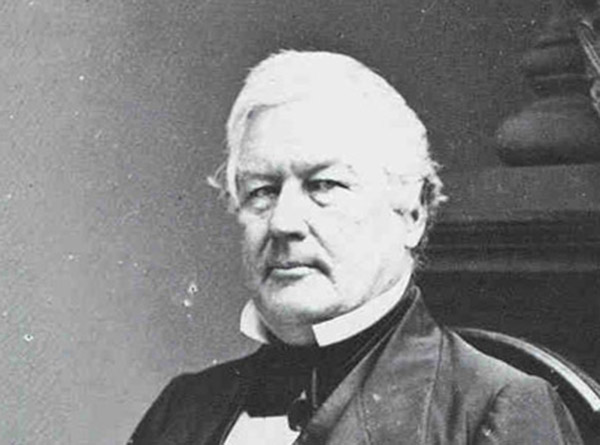He became president when Taylor died. New western lands intensified the slavery issue. The Compromise of 1850 enacted staved off the Civil War for a decade.
Millard Fillmore was born in the Finger Lakes District of New York in a log cabin in 1800. He was the second born and the eldest son of nine children. As a youth he was apprenticed to several clothmakers in order to learn a trade. Obtaining an in a frontier community was difficult for Fillmore yet he managed to receive some formal education and became a law clerk for a local judge and began his study of law.
Fillmore Marries at Twenty-six
Fillmore relocated to Buffalo where he continued his law studies and was admitted to the New York State bar in 1823. While courting his bride-to-be opened his law practice.in 1825
Fillmore married Abigail Powers, a schoolteacher, in 1826.
The first several years of their marriage were met with the not unusual hardships with trying to become established in a profession.
Fillmore Enters Politics
In 1828, Millard Fillmore was elected to the New York State General Assembly as a member of the Anti-Masonic Party, which was attempting to establish itself as a third major based on the single issue of opposing freemasonry. In 1832, as a Whig candidate he was elected to the United States House of Representative and served from 1832 until 1843 acting as chairman of the powerful House Ways and Means Committee in his final two years in Congress, declining to run in the 1842 election.
Parallel to this political involvement, Fillmore was building up a law practice which he helped form in 1834 and was gaining a reputation as one of the most respected lawyers in western New York State.
After leaving Congress, Fillmore ran unsuccessfully to become Governor of New York being defeated by the Democratic candidate Silas Wright in a close election.
In 1848 Millard Fillmore became the first elected New York State Comptroller and in that office over the next two years instituted numerous reforms to New York State policies and procedures.
Presidential Campaign of 1848
The United States in the settlement of the dispute with Great Britain over the Oregon Territory, the acquisition of new territories of the American Southwest as a result of the Mexican American War, and the annexation of Texas had essentially led to a situation of potential instability due to how states would be admitted to the Union, free or slave.
Factions within the Whig Party were unhappy with the nomination of Zachary Taylor from Tennessee. As a compromise Millard Fillmore’s name was proposed as a “balancing element, coming from a free state, New. York.
The ticket of Taylor and Fillmore defeated the democratic ticket led by Lewis Cass in a three man race which included former President Martin Van Buren.
The Fillmore Presidency
Upon the death of President Zachary Taylor, Fillmore became President. American poliics was entering a new age. Fillmore replaced all cabinet official from the Taylor Administration who were opposed to the Compromise of 1850.
The Compromise, provided a means of forestalling internal hostilities which would erupt in the beginning of the American Civil War for a decade. Yet, in his attempt to preserve the Union in the passage of the Fugitive Slave Act he angered the North. In the banning of the slave trade in Washington, D.C. He angered the South.
The compromising attitude of Millard Fillmore cost him the Whig Party nomination in 1852, which was given to General Winfield Scott who was soundly defeated by soundly defeated in the election by Franklin Pierce of New Hampshire.
Fillmore was to run again as a third party candidate for the Know-Nothing Party, and although he captured a respectable 20% of the popular vote but carried only one state, Maryland. Millard Fillmore’s political career was essentially over at age 56.








